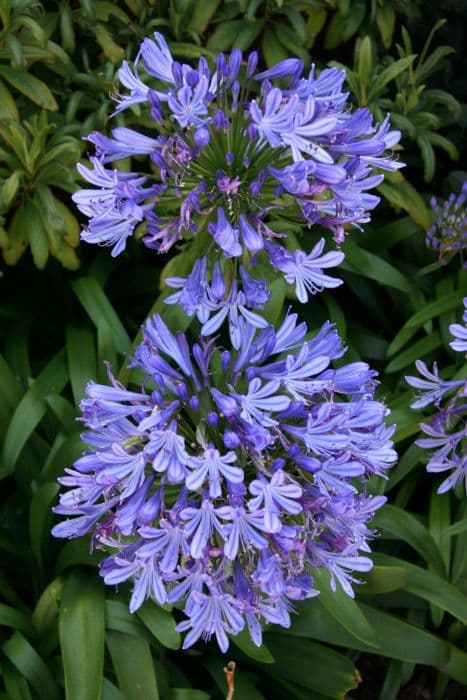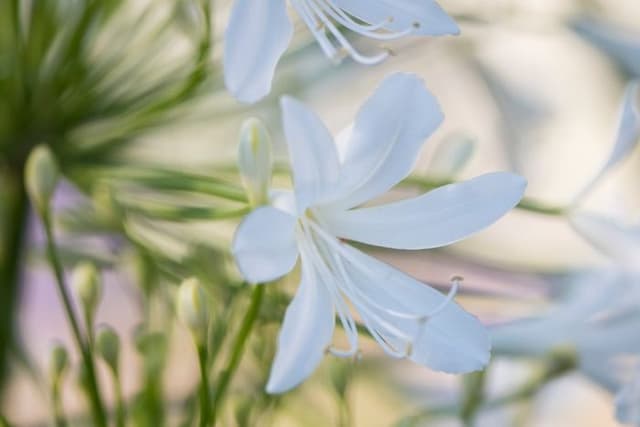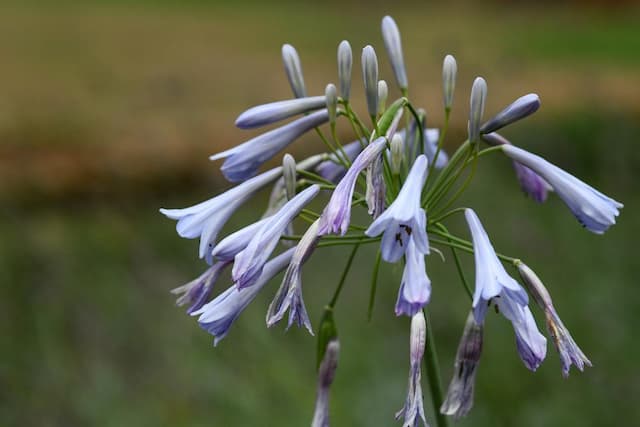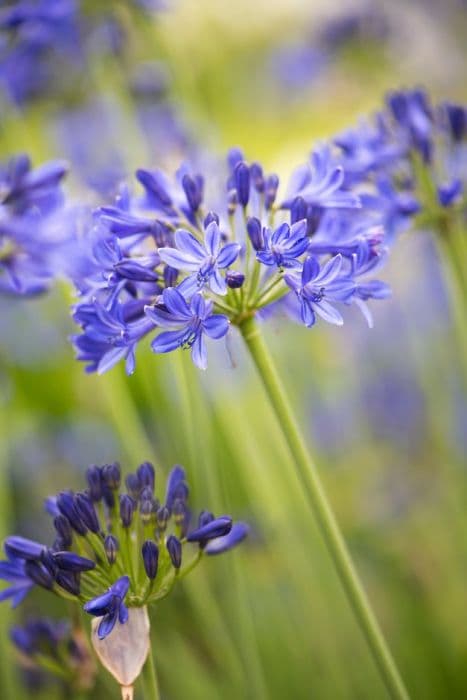African lily Agapanthus 'Southern Cross'

ABOUT
The Agapanthus 'Southern Cross', often referred to as the Lily of the Nile or African Lily, is a striking ornamental garden plant characterized by its lush foliage and vibrant blooms. The plant typically showcases a clump of glossy, strap-like green leaves that provide a verdant backdrop for its flowers. These leaves emanate from the base in an arching manner, lending a graceful and dense appearance to the foliage. Rising above the foliage, the plant displays rounded clusters of flowers, known as umbels, which sit atop stout and upright stems. These blooms are typically a beautiful shade of blue or sometimes white, depending on the variety. Each cluster is made up of numerous trumpet-shaped flowers, small and delicate, which open from the bottom upwards, creating a spherical display of color that is reminiscent of fireworks. The flowers of the Agapanthus 'Southern Cross' are particularly noted for their striking hue and profusion, often attracting a buzz of pollinating insects such as bees and butterflies. The contrast between the dark, lush foliage and the bright, almost luminescent quality of the flower umbels makes this plant a showcase specimen in any garden setting, providing both textural and visual interest.
About this plant
 Names
NamesFamily
Amaryllidaceae
Synonyms
African Lily, Lily of the Nile
Common names
Agapanthus 'Southern Cross'
 Toxicity
ToxicityTo humans
The Agapanthus, commonly known as Lily of the Nile, contains toxic substances that can be harmful if ingested. While the level of toxicity is generally considered low for humans, consumption of any part of the plant can still lead to symptoms such as nausea, vomiting, abdominal pain, and diarrhea. It is advised to keep the plant out of reach of children who might accidentally ingest it. If someone does consume Agapanthus and shows symptoms of poisoning, it is important to seek medical attention.
To pets
Lily of the Nile is toxic to pets, especially cats and dogs. Ingesting any part of the plant can lead to symptoms such as vomiting, diarrhea, nausea, abdominal pain, and drooling. In some cases, ingestion can also lead to tremors or cardiac arrhythmia. As pets are more likely to chew on plants, it is important to keep Agapanthus away from them. If you suspect your pet has ingested this plant, contact a veterinarian or an emergency animal poison control service immediately.
 Characteristics
CharacteristicsLife cycle
Perennials
Foliage type
Evergreen
Color of leaves
Green
Flower color
Blue
Height
2 feet (60 cm)
Spread
2 feet (60 cm)
Plant type
Herb
Hardiness zones
8
Native area
South Africa
Benefits
 General Benefits
General Benefits- Attractive Flowers - The Agapanthus 'Southern Cross', commonly known as Lily of the Nile, boasts striking blue or violet flowers arranged in a spherical inflorescence, adding visual appeal to gardens and landscapes.
- Low Maintenance - Once established, Lily of the Nile requires minimal care, making it suitable for gardeners who prefer low-maintenance plants.
- Drought Tolerance - This plant is relatively drought-tolerant, which is beneficial for regions with water restrictions or for gardeners aiming to conserve water.
- Long Blooming Season - Lily of the Nile has a long flowering period, which can last from early summer to fall, providing a lengthy display of color.
- Border Plant - Its neat clumping habit and upright flowering stems make it ideal for use as a border plant in garden beds and walkways.
- Attracts Pollinators - The flowers attract various pollinators such as bees and butterflies, supporting biodiversity in the garden.
- Deer Resistance - Lily of the Nile is known to be resistant to deer, which can be beneficial in areas where deer browsing is a problem for gardeners.
 Medical Properties
Medical PropertiesThis plant is not used for medical purposes
 Air-purifying Qualities
Air-purifying QualitiesThis plant is not specifically known for air purifying qualities.
 Other Uses
Other Uses- Artistic Inspiration: The striking blue-violet flowers of the Agapanthus can serve as a subject or inspiration for painters, photographers, and other visual artists looking for natural beauty to capture.
- Educational Tool: Botany students and educators can use the Agapanthus to demonstrate plant growth habits, reproductive systems, and the impact of climate on perennial plants.
- Bee and Butterfly Attraction: The nectar-rich blooms of the Agapanthus 'Southern Cross' can be used in gardens designed to attract and support pollinators like bees and butterflies.
- Culinary Decor: Although not a common practice, the flowers can sometimes be used as a decorative, non-toxic garnish for salads and desserts for a touch of elegance.
- Eco-Friendly Dye: The flowers and leaves of the Agapanthus may be used to create natural dyes for fabrics, yarns, and handicrafts, promoting sustainability in art.
- Feng Shui: Some practitioners may use the Agapanthus to balance energy in home gardens, as its lush foliage and blossoms are thought to contribute to a serene environment.
- Floral Arrangements: The long-lasting cut flowers of the Agapanthus make them suitable for use in large, ornamental floral displays and bouquets.
- Garden Borders: Their clumping growth habit makes Agapanthus an excellent choice for defining borders and edges in landscape design.
- Stormwater Management: Due to their root structure, Agapanthus can be incorporated into rain gardens which help to manage stormwater runoff and prevent soil erosion.
- Creative Writing: The beauty and distinct appearance of the Agapanthus can be used as a symbol or motif in poetry, literature, and creative writing.
Interesting Facts
 Feng Shui
Feng ShuiThe Agapanthus, commonly known as the Lily of the Nile, is not traditionally used in Feng Shui practice.
 Zodiac Sign Compitability
Zodiac Sign CompitabilityThe Lily of the Nile is not used in astrology practice.
 Plant Symbolism
Plant Symbolism- Love Letters: Agapanthus, commonly known as the Lily of the Nile, although not actually a lily, often symbolizes love letters or love messages, as its name is derived from the Greek words 'agape' meaning love, and 'anthos' meaning flower.
- Beauty: This plant is often associated with beauty due to its striking blue flowers and lush foliage, suggesting the appreciation of natural aesthetics.
- Endurance: With its ability to thrive and bloom even in adverse conditions, the Lily of the Nile symbolizes endurance and the ability to overcome challenges.
 Water
WaterAfrican Lilies should be watered deeply once or twice a week during their active growing season in the spring and summer, with the soil allowed to dry out slightly between waterings. They require less water during the fall and winter months, roughly every two to three weeks, or when the top inch of soil feels dry. Generally, it's best to provide about 1 gallon of water per square yard each week during the active growing season, adjusting for rainfall. Overwatering can lead to root rot, so ensure proper drainage.
 Light
LightAfrican Lilies thrive best in full sun, receiving at least six hours of direct sunlight daily. An ideal spot is a south-facing garden area that is unobstructed by trees or buildings. They can also tolerate partial shade, particularly in hotter climates, as long as they get a substantial amount of direct sunlight.
 Temperature
TemperatureAfrican Lilies prefer moderate temperatures and can typically withstand minimum temperatures of around 50 degrees Fahrenheit without taking damage. They are hardy to USDA zones 8 through 11 and thrive in temperatures ranging between 60 and 75 degrees Fahrenheit. It's crucial to protect them from frost, which can be detrimental to the plant's health.
 Pruning
PruningPruning African Lilies is beneficial to remove spent flower stalks and encourage additional blooming. Cut back the flower stems to the base after blooming, usually in the late summer or fall. Additionally, in spring, remove any dead or damaged leaves to keep the plant tidy and healthy. Pruning is typically done annually or as needed after flowering.
 Cleaning
CleaningAs needed
 Soil
SoilThe best soil mix for African Lily (Agapanthus 'Southern Cross') is well-draining, fertile loam enriched with compost. It prefers a pH range of 6.0 to 8.0. Add perlite or gravel for improved drainage, crucial for healthy root development.
 Repotting
RepottingAfrican Lily should be repotted every 3 to 4 years, or when it becomes root-bound. Repotting is best done in the spring, just before the growing season begins.
 Humidity & Misting
Humidity & MistingAfrican Lily thrives in moderate humidity levels but is quite adaptable to different humidity conditions, as long as it is not too dry. No specific humidity level is required.
 Suitable locations
Suitable locationsIndoor
Place African Lily in bright, indirect light and water when soil's dry.
Outdoor
Plant African Lily in full sun to partial shade in well-draining soil.
Hardiness zone
8-11 USDA
 Life cycle
Life cycleThe life cycle of the Agapanthus 'Southern Cross', commonly known as the African Lily, begins with seed germination, where under appropriate conditions of warmth and moisture, the seeds sprout and form small seedlings. These seedlings then develop a root system and foliage, growing into juvenile plants. As the African Lily matures, it forms strap-like leaves and establishes a strong root system, typically within a clump. The next stage is flowering, usually occurring in summer, when the African Lily produces tall stalks topped with clusters of blue or white trumpet-shaped flowers. Following pollination, the flowers give way to seed pods, which eventually dry and release seeds, completing the reproductive cycle. The plant often enters a period of dormancy in colder months, with growth and flowering resuming in the following season.
 Propogation
PropogationPropogation time
Spring-Early Summer
The Agapanthus 'Southern Cross', commonly known as the African Lily or Lily of the Nile, is widely propagated through division, which is best done in the spring or early fall. To propagate through division, carefully lift the parent plant out of the soil, making sure to minimize root damage. Once the clump is out, use a sharp knife or spade to cut through the thick, fleshy roots, creating sections that each have at least one shoot and a portion of the root system. After the division, replant the sections at the same depth they were growing before, which is typically no more than 1-2 inches (2.5-5 centimeters) below the soil surface. Water the newly planted divisions thoroughly to help establish them. This method of propagation is quite effective and maintains the genetic characteristics of the cultivar.









